9 Types of Hawks in Delaware (With Pictures)
There are a total of 9 different species of hawks in Delaware. Among all of them, the most common species is the Red-tailed hawk. And the rarest hawk in the state is the Northern Goshawk.
Did you happen to spot one while cruising around the streets? Want to know which species you have come across? You would want to continue reading as you can find all the info you need regarding the hawks found in Delaware.
Are There Hawks in Delaware?
In total, you can spot 9 different species of hawks in Delaware. That includes the Broad-tailed hawk, Norther goshawk, Cooper’s hawk, Northern harrier, Red-shouldered hawk, and Rough-legged hawk.
9 Species of Hawk in Delaware
Like some of the other states, hawks are pretty common in Delaware. However, some are more common than others, while some can only be seen at certain times of the year. Let’s take a deep dive and learn all about the hawks you can spot in the state, shall we?
1. Sharp-shinned Hawk (Accipiter striatus)
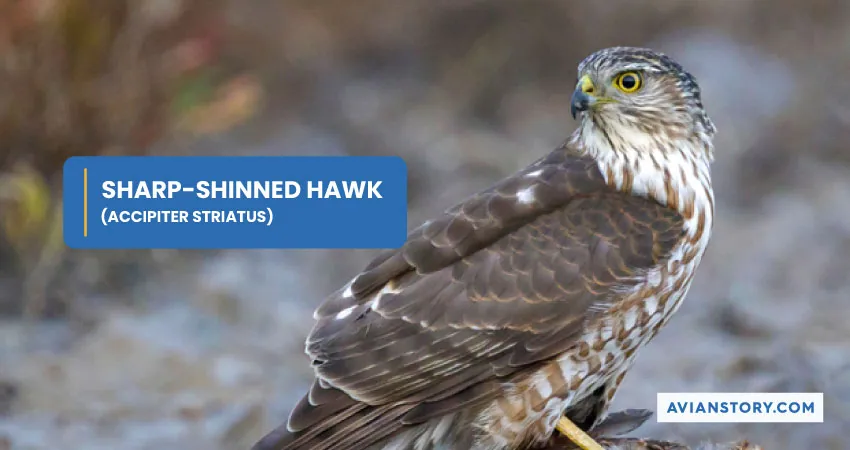
Among all the species available in Delaware, Sharp-shinned hawks are the smallest ones. But the good news is that you will be able to spot them throughout the entire year in Delaware. And the best time to spot them is during the fall. That is when they start their migration.
Attributes
As stated above, Sharp-shinned hawks are pretty small in size. To give you an idea, they are a little bit larger than a Jay and smaller than a crow. And in comparison, female Sharp-shinned hawks are 1/3rd larger than the males.
Apart from that, these hawks have short and rounded wings. They have a blue-gray coloration across the body and a red-orange coloring in the chest. Across their long tails, there are dark bands. And their tails tend to have a square end.
Sharpies can also have cream coloring on their chest with reddish-orange barring. And they look pretty similar to a Copper’s hawk.
Diet
The diet of Sharp-shinned hawks primarily consists of small birds. For that reason, you will often find them near bird feeders. To be exact, 90 percent of the diet has songbirds. Other than small birdies, sharpies munch on lizards, squirrels, rodents, bats, snakes, frogs, and large-sized insects.
Nesting Preference and Eggs
Finding the nests of Sharp-shinned hawks is not easy. They are pretty secretive, meaning they hide their homes in densely packed trees. So, to find their nests, look for conifer trees with dense cover. And when it comes to the nesting spot, these raptors prefer the highest points of the trees.
If you happen to find their nests during the breeding season, you will find 4 to 5 blue-white eggs. Their eggs might also have brown markings on the top.
2. Cooper’s Hawk (Accipiter Cooperii)
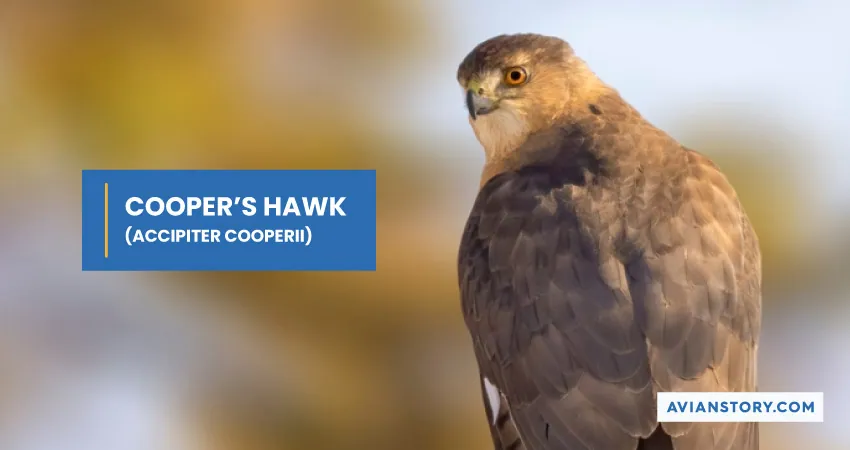
Like Sharp-shinned hawks, you will be able to find Cooper’s hawks all around the year in Delaware.
Attributes
Cooper’s hawks are pretty similar to Sharp-shinned hawks in terms of appearance. They have the same blue-gray coloring on their backs and red-orange coloration on their chest. In fact, they even have dark bands that are present on the tails of the sharpies.
However, they are way larger than Sharp-shinned hawks. To be exact, they are similar to crows in terms of size. Another standout trait of these raptors is their heads, which are larger and project well beyond their wings.
Diet
These raptors like to feed on birds. Small mammals and medium-sized birds acquire a big chunk of their diets. They also munch on the songbirds that hover around the bird feeders.
Nesting Preference and Eggs
Cooper’s hawks prefer to nest in woodlands and forests. However, it is not uncommon for them to settle in suburban areas. No matter where they are nesting, they will choose the highest points. And sometimes, they even reuse old nests of other large-sized birds.
In the breeding season, females can lay 3 to 5 eggs. Their eggs are bluish-white in color.
3. Red-shouldered Hawk (Buteo lineatus)
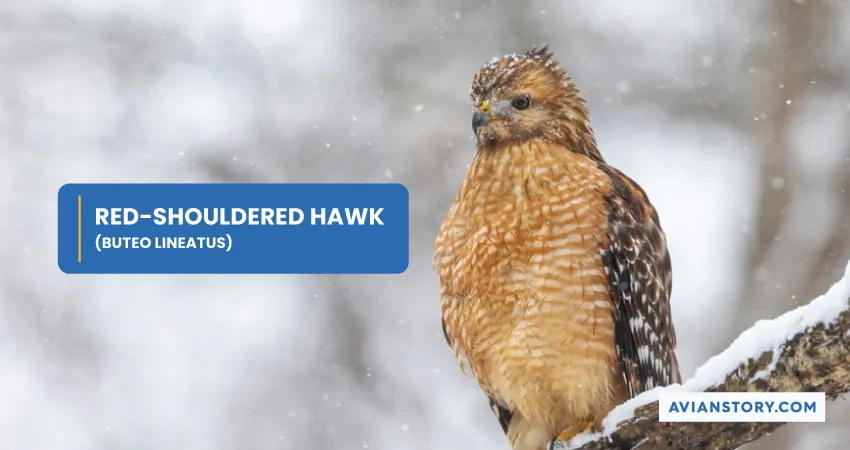
Although Red-shouldered hawks are preset all-around the year in Delaware, you have a better chance of spotting them during the winter months. That is from December to February.
Attributes
The best identifying feature of these raptors is the heavy red coloration on their chests. This coloration starts from their breasts and extends to their belly. And around their belly, you will also find red barring.
Besides, the red-shouldered hawks have nearly black feathers on their wings and backs. Around their shoulders and backs, they have reddish feathers, which is precisely why they are called red-shouldered hawks.
But if you cannot spot them through their appearance, wait for their calls. They are famous for their loud “kee-aah” sound.
Diet
These raptors primarily feed on small mammals and aquatic animals. And in terms of aquatic animals, they tend to fest on frogs and snakes. But you will also catch them hunting lizards.
Nesting Preference and Eggs
Red-shouldered hawks tend to reuse the same old nests every year. And as you might have guessed after knowing about their diets, they most nest around water bodies. In other words, they like quick access to their favorite food. Tall trees near water bodies are the perfect nesting spots for these birds.
If you stumble upon their nests in the breeding season, you will find 3 to 4 bluish-to-white colored eggs inside.
4. Broad-winged Hawk (Buteo platypterus)
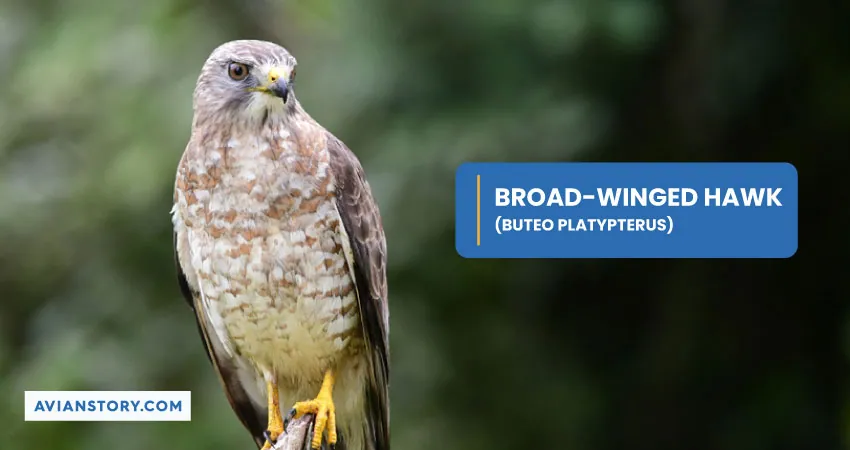
In Delaware, you will only find Broad-winged hawks when they are migrating. In other words, they can only be spotted between spring and summer. Also, they are most common in the northern part of Delaware.
Attributes
These birds are true to their names. They have short but broad wings. When it comes to coloration, they have brown chests and heads with barred underparts. Their tails are short and have white bands. Also, their broad wings have pointy tips, which are highly visible when they are in flight.
In terms of size, these raptors have compact and stocky bodies. To be exact, they are in the middle of a goose and a crow.
Diet
The diet of Broad-winged hawks mainly consists of small mammals, amphibians, and insects. Around water bodies, they mostly hunt young turtles, frogs, and snakes. So, you could say that their diet is pretty diverse.
Nesting Preference and Eggs
For nesting, Broad-winged hawks prefer spots that are far from humans. That is, they will choose a secluded area such as a forest. Generally, they will find a spot near water bodies where they can easily hunt amphibians.
In terms of the size of their clutch, it is generally 1 to 5 eggs. And their eggs are known to be whitish in color. However, some can also have brown spotting.
5. Red-tailed Hawk (Buteo jamaicensis)
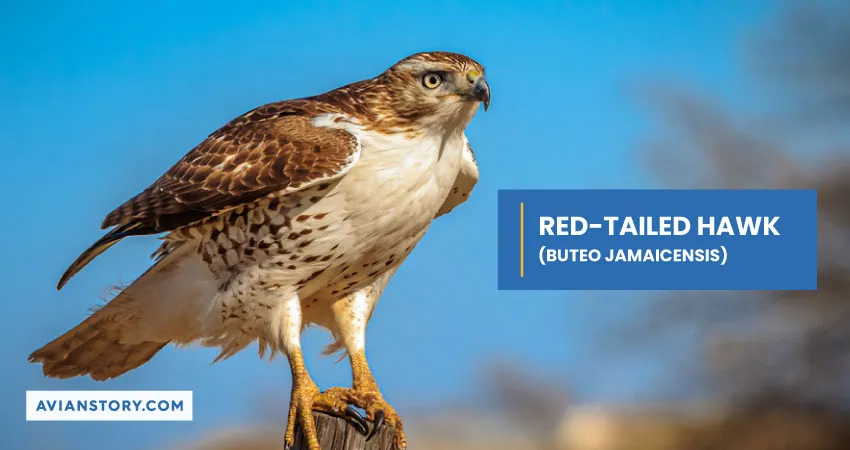
The Red-tailed hawks are very common in Delaware. Although you can spot them throughout the year, their population increases significantly during the winter.
Attributes
Red-tailed hawks are another species that is also true to their name. The tails of the adults have a brick-red color, which is pretty easy to identify. However, juveniles will most have brown tails with white strips.
Apart from that, these raptors are also easy to identify when you look at their wings, which tend to be large, broad, and rounded. Also, they have brown coloring on their backs and pale feathers underneath. And let’s not forget to tell you about their iconic whistle, which is high-pitched, raspy, and very easy to notice.
Diet
These birds of prey will mostly feed on small mammals, reptiles, and small-sized birdies. However, they can surely take on large-sized birds and medium-sized reptiles if they want to.
Nesting Preference and Eggs
When it comes to nesting preference, Red-tailed hawks choose the tallest point they can get their eyes on. And you can find their homes in tall towers, buildings, cliff edges, and trees. Basically, wherever these birds can have a commanding view of the environment is the right pick for nesting.
During the breeding season, which starts in March and runs through May, you can find 1 to 4 whitish eggs inside their nests.
6. Rough-legged Hawk (Buteo lagopus)
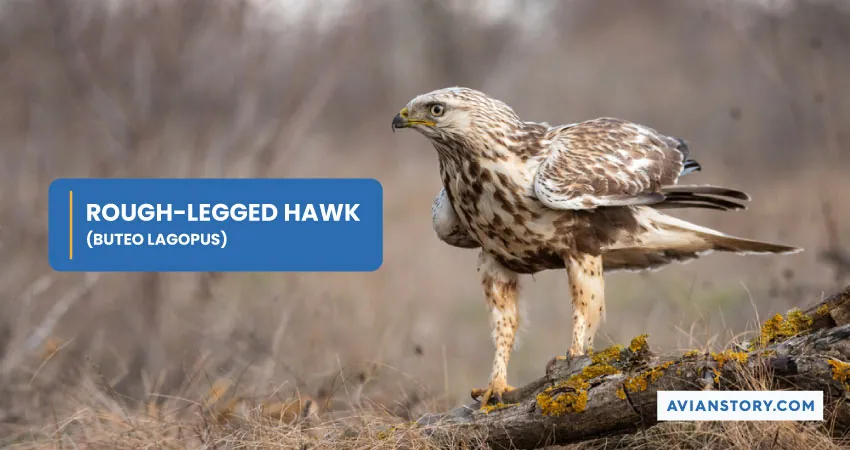
Although Rough-legged hawks are not considered a common raptor in Delaware, you can surely come across a few during the winter. That is when they start migrating to the south. Also, it is possible to see the skies of Delaware during fall.
Attributes
The easiest way to identify a Rough-legged hawk is to notice them during flight. They tend to turn into the wind and flap their wings in order to hover in place. This is how they reach a vantage point, allowing them to quickly examine the area they are in and search for prey.
Aside from that, you can take a look at their legs. They have feathers all the way down to their toes. These feathered-down legs allow the raptors to survive the coldest environments in the northern Arctic.
When it comes to the coloration of the bodies, they are mostly dark brown. And at the end of their tails, you will find dark patches, which are also present through their bellies and the bending point of their wings. Also, they are known to have narrow and broad wings.
Diet
Lemmings and voles are two of the most prominent foods for Rough-legged hawks. However, not all environment has these. That is why they have adapted to hunting mice, ground squirrels, small rodents, and small mammals.
Nesting Preference and Eggs
Preferred spots for nesting of these raptors are in alpine regions, uplands, cliffs, treeless tundra, and boreal forests. And when breeding season arrives, females can lay anywhere from 3 to 5 bluish eggs.
7. Northern Harrier (Circus cyaneus)
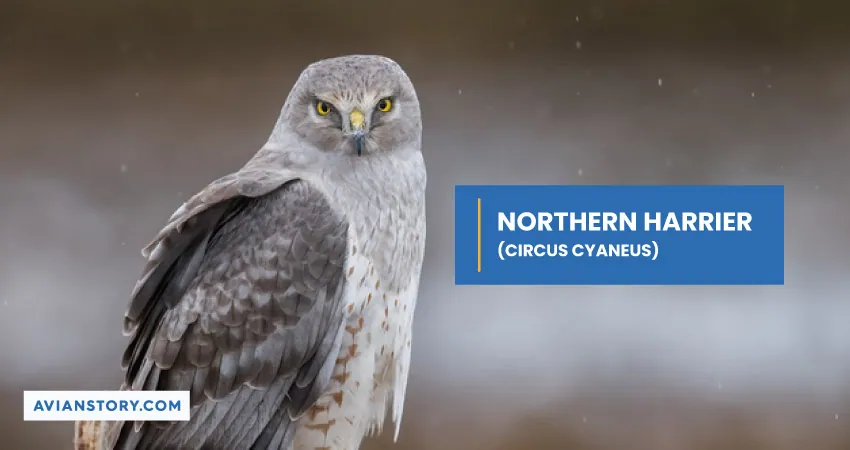
You might not have enough luck in spotting Northern Harriers in Delaware. They are not easily spotted in the state. But if you want to increase your chances, look for them in the winter.
Attributes
Adult Northern Harriers have grey coloring on their bodies. You will notice the white coloration in their underparts, while on their wingtips, there will be black markings. Juveniles and females, on the other hand, are primarily brown.
However, the standout feature of these raptors is the face. They tend to have an owl-like faces. In fact, their face has a disc-shaped structure, which functions pretty similar to the face of an owl.
Another standout trait is their tails, which are relatively longer than other birds of prey. Most of them have a white patch on their tails. Also, they have a distinct flying style. They hold their wings in a “V” shape.
Diet
Northern Harriers live off small birds and small mammals. However, their diet can change with the season. You can often find them munching on large-sized animals.
Nesting Preference and Eggs
These birds of prey are pretty different than other hawks in terms of nesting. Instead of selecting a high point, they will build a platform on the ground. And for this, they will choose dense vegetation, such as cattails, sedges, willows, and reeds.
Females can lay between 4 and 9 eggs. And males are responsible for providing food to their offspring and mate during breeding.
8. Northern Goshawk (Accipiter gentilis)
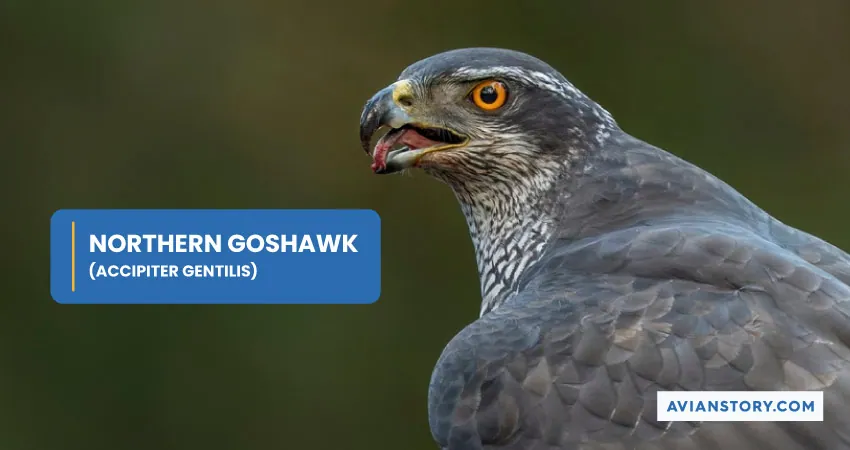
Another rare bird of Delaware is Northern Goshawk. They are mostly present during the winter. However, there have not been many reports from the bird watchers in the area.
Attributes
You can consider Norther Goshawks to be a fiercer and bigger version of Cooper’s and Sharp-shinned hawks. They tend to have large, broad wings and long tails. In terms of coloration, their wings are mostly gray in color.
Other than that, they are known for having a white stripe over their eyes, while their eyes are mostly yellow.
Diet
Northern Goshawks are highly adaptive when it comes to diet. They are not picky about food and will eat anything that is available in the surroundings. But in general, they rely on insects, mammals, reptiles, and other birds.
Nesting Preference
These birds of prey are another species of hawks that are secretive about their nests. They tend to pick the highest points of trees found in large forests. And females can lay 2 to 4 blue-colored eggs.
9. Swainson’s Hawk (Buteo swainsoni)

Like the previous two hawks, Swainson’s hawks are not that common in Delaware. But if you are lucky enough, you can catch them flying in the skies of the state in late August. It is the time when these hawks migrate.
Attributes
The most identifiable feature of these hawks is their wingtips and tails. They are known for having short tails and pointy wingtips. And these two traits become highly noticeable when they are flying in the sky.
During the flight, it is also easier to notice the contrast of colors that are present in their flight feathers. Mostly, they have white upper wings and black coloration on the feathered tips.
When it comes to the color of their bodies, it is mostly gray or brown. Their chest, on the other hand, is generally red in color. And their bellies are known for having a light color.
Diet
Swainson’s hawks do not stick to any particular diet. They adapt to whatever is available in the area. But, in general, their diet consists of rabbits, mice, and bats. These raptors can also eat insects, which include dragonflies and crickets.
Nesting Preference and eggs
These raptors like to choose tall points for nesting. That includes high buildings, tall power poles, and utility poles in urban areas. In the wild, they will build homes in tall trees.
Females can lay 2 to 4 eggs in the breeding season. And their eggs are known to be white in color.
| Name | Length | Weight | Wingspan | Commonly Found In | Behavior | Fun Fact |
| Sharp-shinned Hawk | 9.4 to 13.4 inches | 0.19 to 0.48 pounds | 16.9 to 22.1 inches | Near backyards with feeders. | Solitary but can be highly territorial during the breeding season. | Sharp-shined hawks are the smallest hawks of the United States and Canada. |
| Cooper’s Hawk | 14.6 to 17.7 inches | 0.49 to 1.5 pounds | 24.4 to 35.4 inches | Woodlands, dense forests, and near backyard feeders. | Territorial and aggressive. | Cooper’s hawks are known to mate only once in their entire lifespan. |
| Red-shouldered Hawk | 16.9 to 24.0 inches | 1.07 to 1.71 pounds | 37.0 to 43.7 inches | Around water bodies, wet forests, and open forests. | Solitary and very territorial | The eye colors of red-shouldered hawks change as they grow older. |
| Broad-winged Hawk | 13.4 to 17.3 inches | 0.58 to 1.24 pounds | 31.9 to 39.4 inches | Mixed deciduous and dense deciduous forests. | These birds are primarily territorial. But when they are not migrating, they can stay solitary. | When Broad-winged hawks migrate, they fly in swirling flocks. |
| Red-tailed Hawk | 17.7 to 25.6 inches | 1.52 to 3.22 pounds | 44.9 to 52.4 inches | Around the edges of roads and areas with many trees around. | Territorial | Red-tailed hawks are the second largest hawks in North America. |
| Rough-legged Hawk | 18.5 to 20.5 inches | 1.58 to 3.09 pounds | 52.0 to 54.3 inches | Near nestles of tundra and cliffs of low-lying boreal forests | Territorial | The Rough-legged hawks get their name for having feathers all the way to their toes. |
| Northern Harrier | 16.14 to 19.68 inches | 0.69 to 1.69 pounds | 41 to 46 inches | Marshes, prairies, fields, grasslands, and other open areas. | Primarily solitary | Northern harriers are known to have a remarkable sense of hearing. |
| Northern Goshawk Hawks | 20.9 to 25.2 inches | 1.40 to 3.01 pounds | 40.5 to 46.1 inches | Mixed forests or coniferous forests. | Highly territorial | The Northern Goshawks are the only birds of prey in the genus found in North America and Eurasia. |
| Swainson’s Hawk | 18.9 to 22.1 inches | 1.53 to 3.01 pounds | 46 to 54 inches | Open areas such as grassy areas and large fields. | Can become highly territorial when breeding. | Swainson’s hawks are known for being the longest migrants of North America. |
Conclusion
To recapitulate, it is possible to spot a total of 9 different hawks in Delaware. But among all of them, you have higher chances of spotting Red-tailed, while the chances are lower for Northern Goshawk, Northern Harrier, and Swainson’s hawks.
References and Sources:
- https://www.nps.gov/upde/learn/nature/baldeagles.htm#:~:text=More%20than%20100%20eagles%20migrate,the%20Upper%20Delaware%20river%20valley
- https://www.audubon.org/field-guide/bird/bald-eagle
- https://www.audubon.org/field-guide/bird/golden-eagle
Feature Image Credits: Touched by light images, Shutterstock
